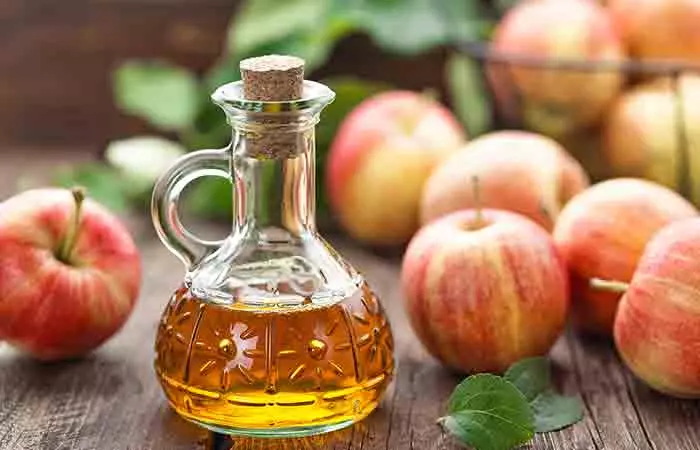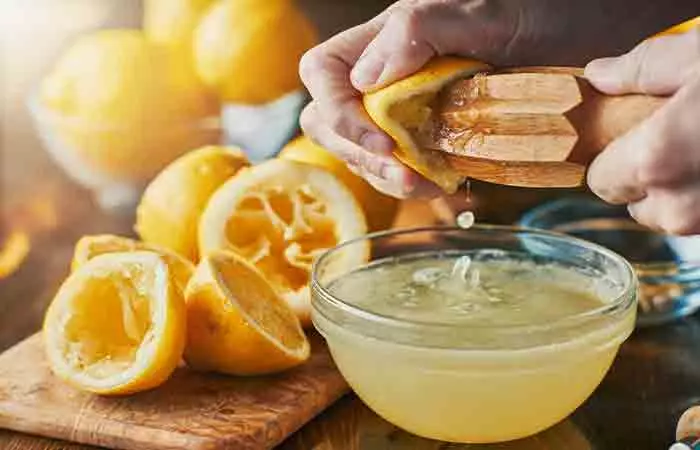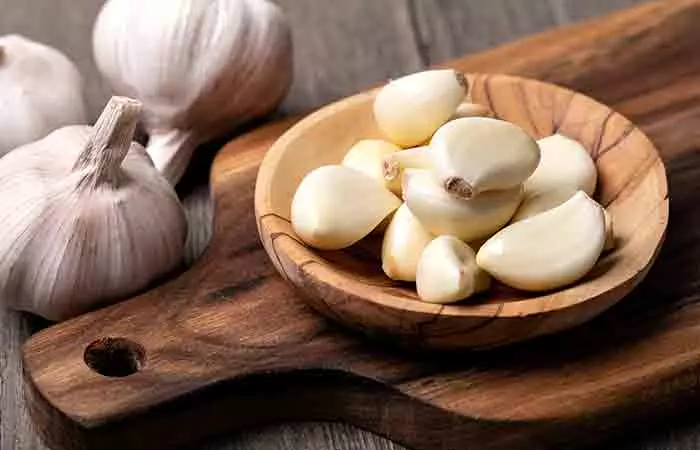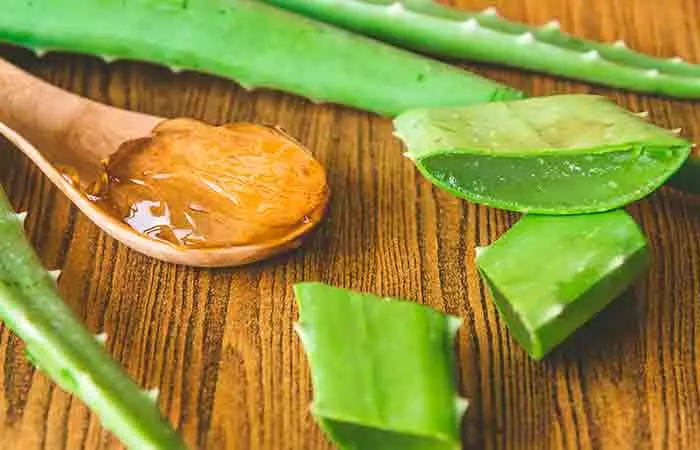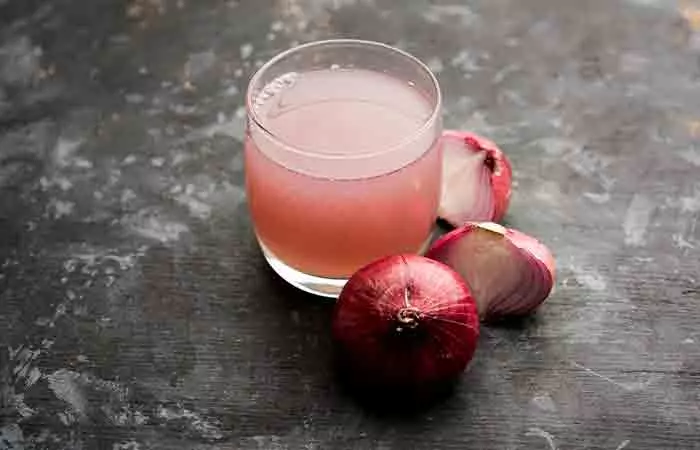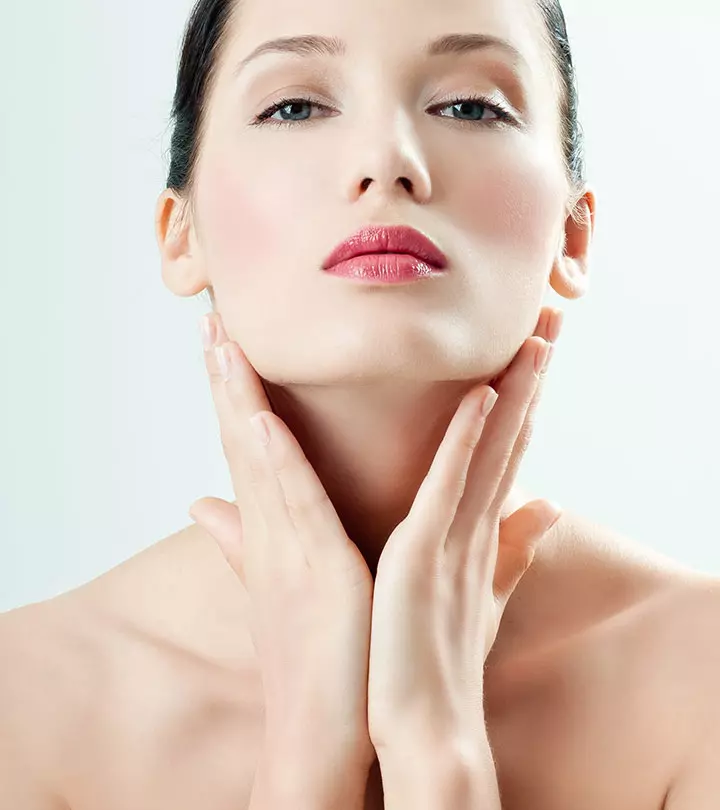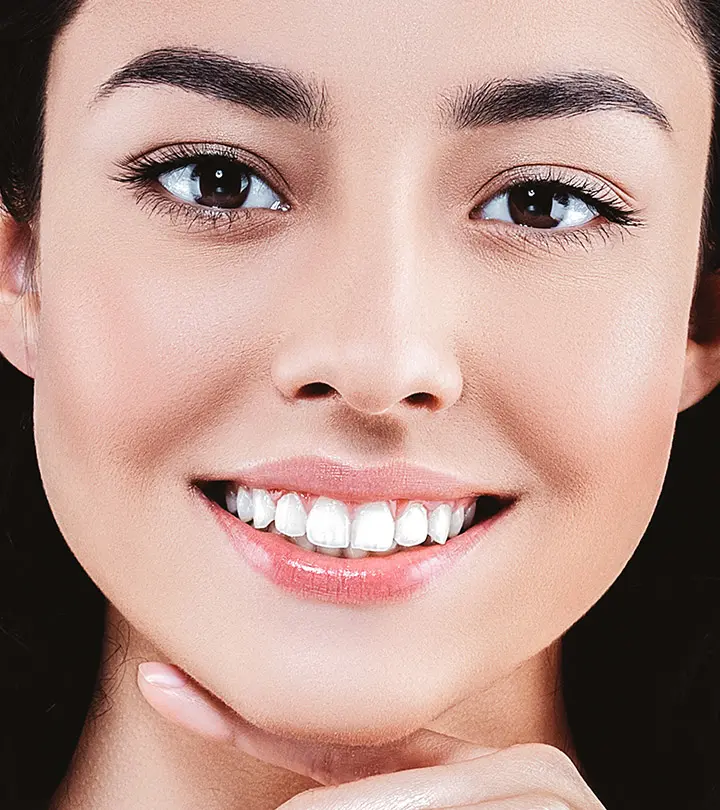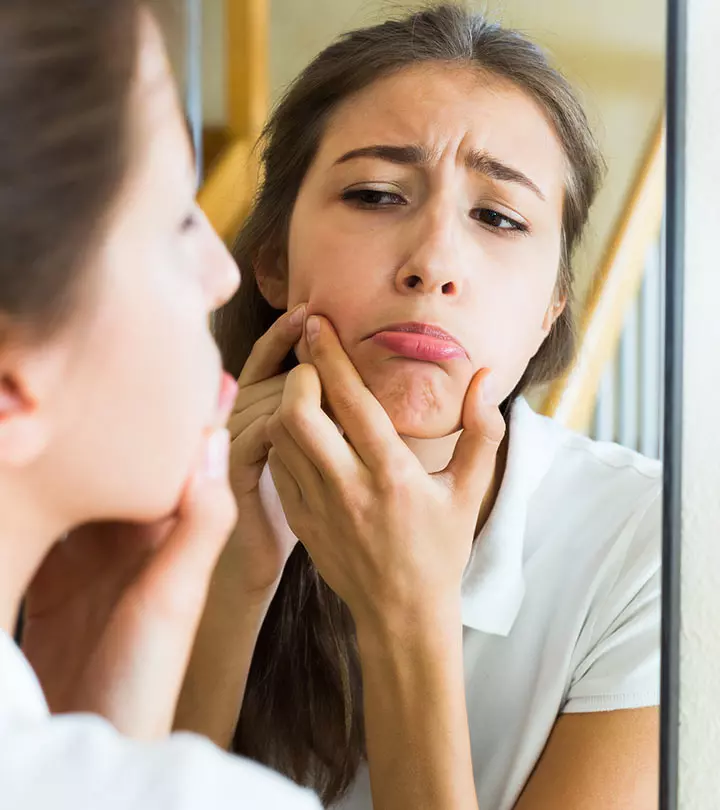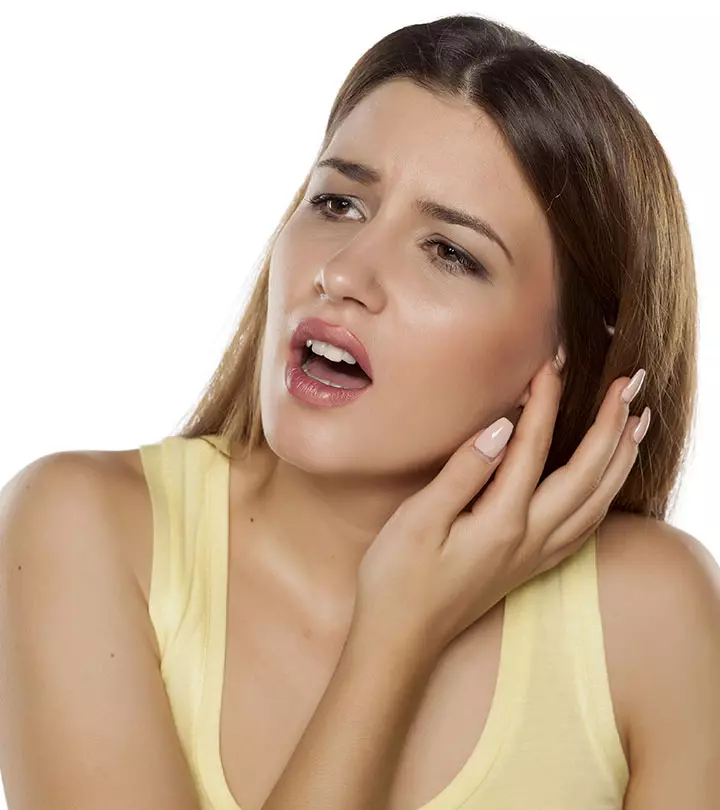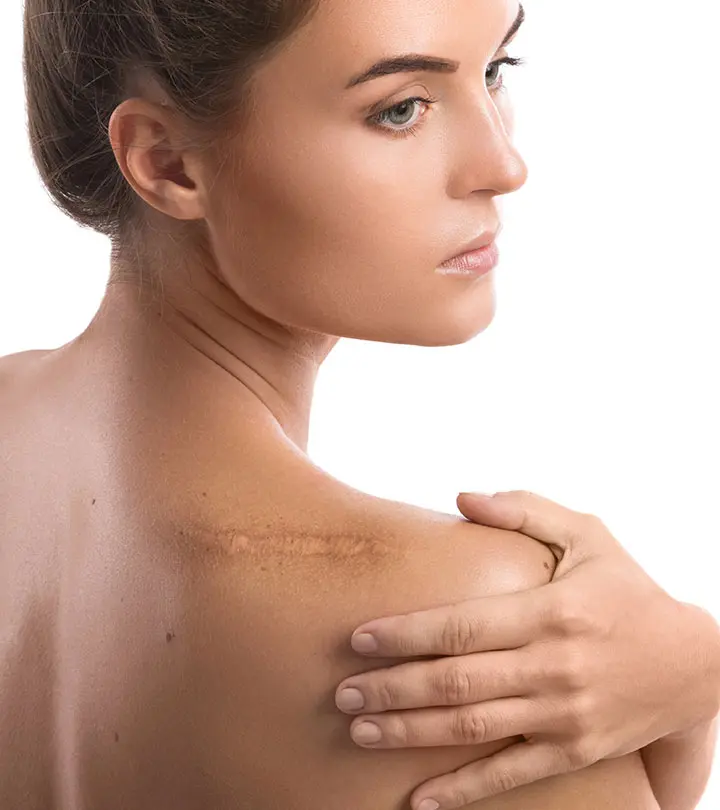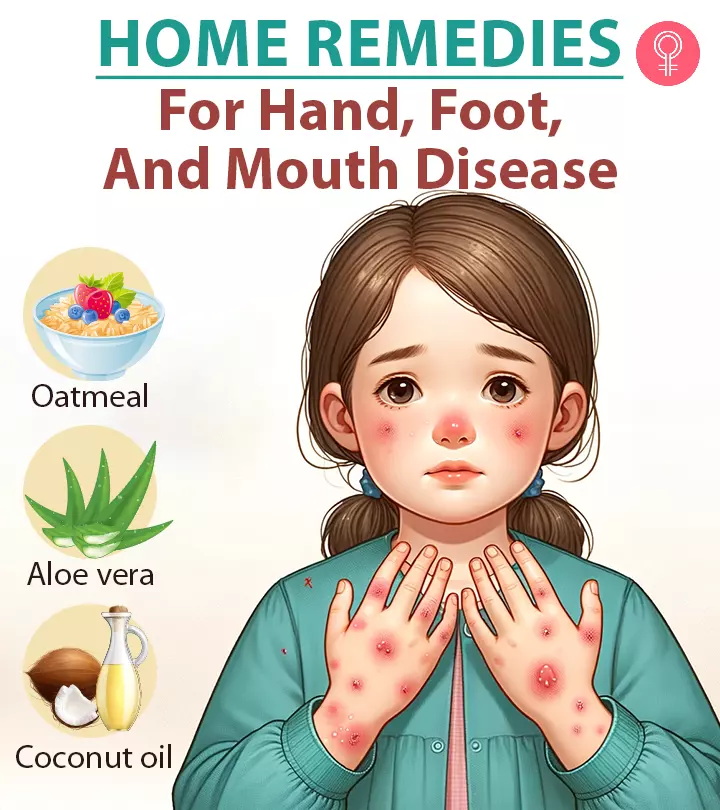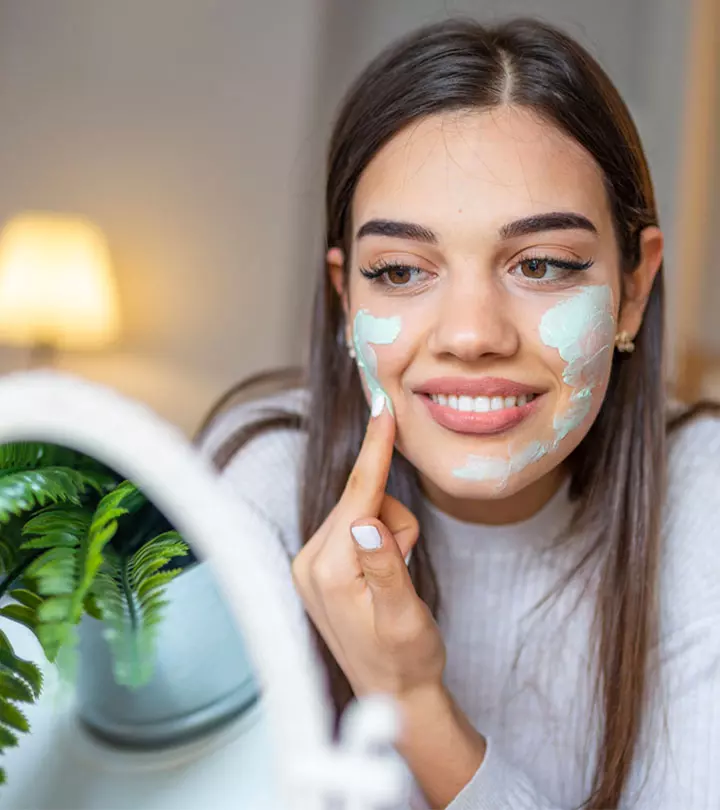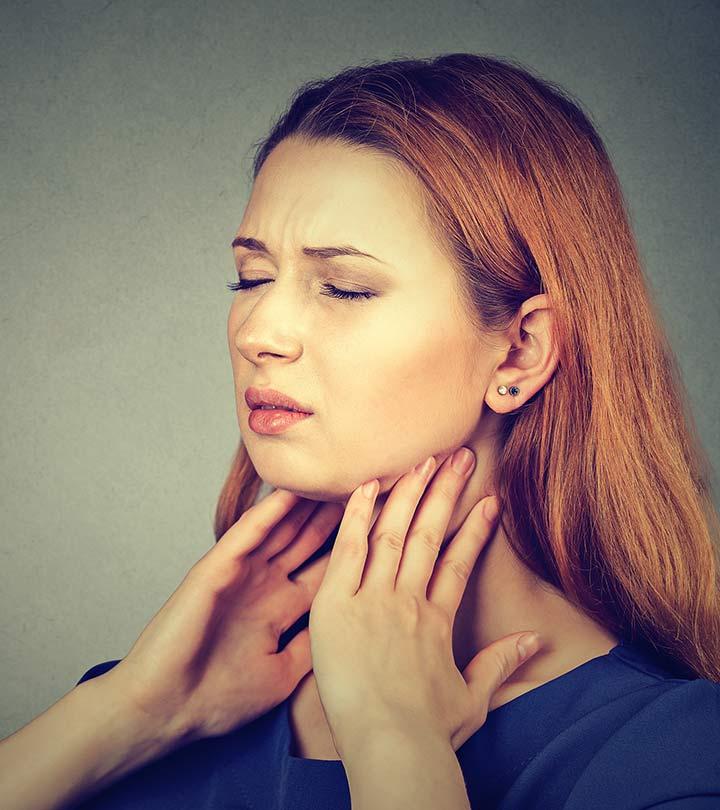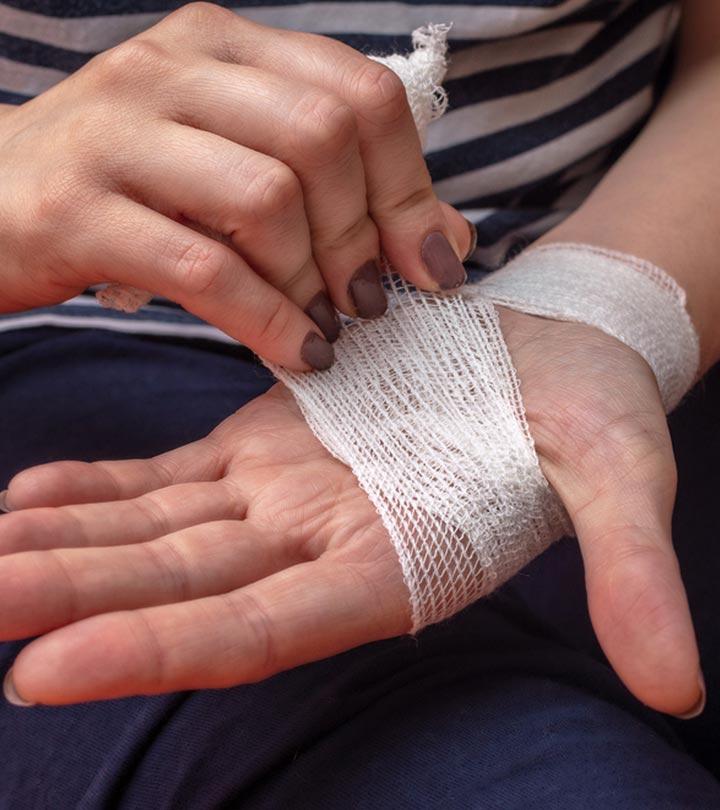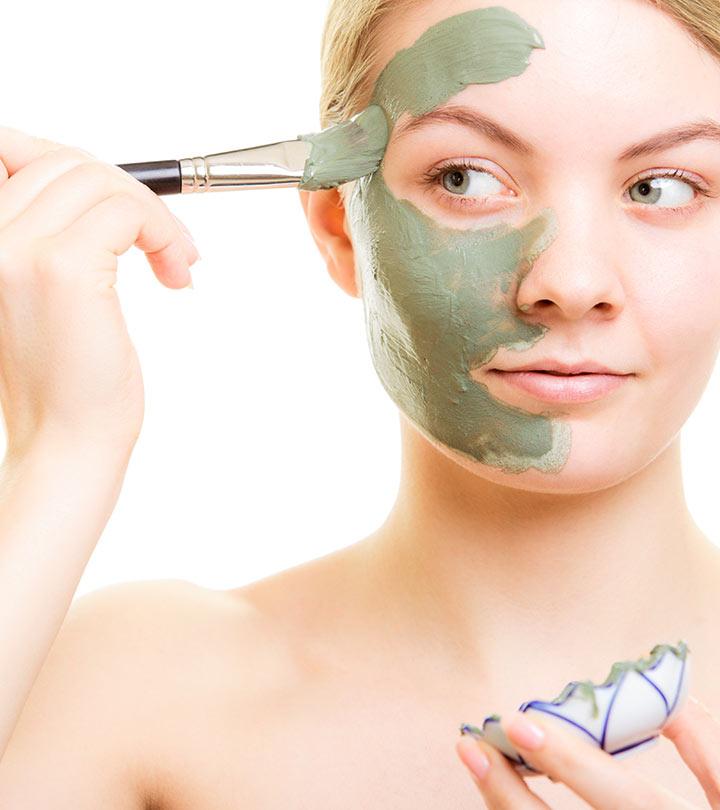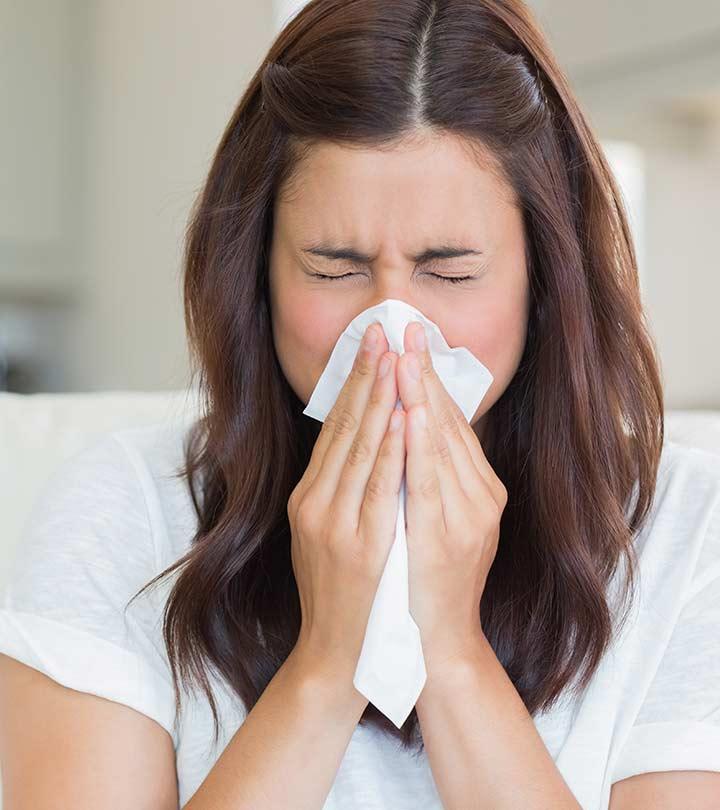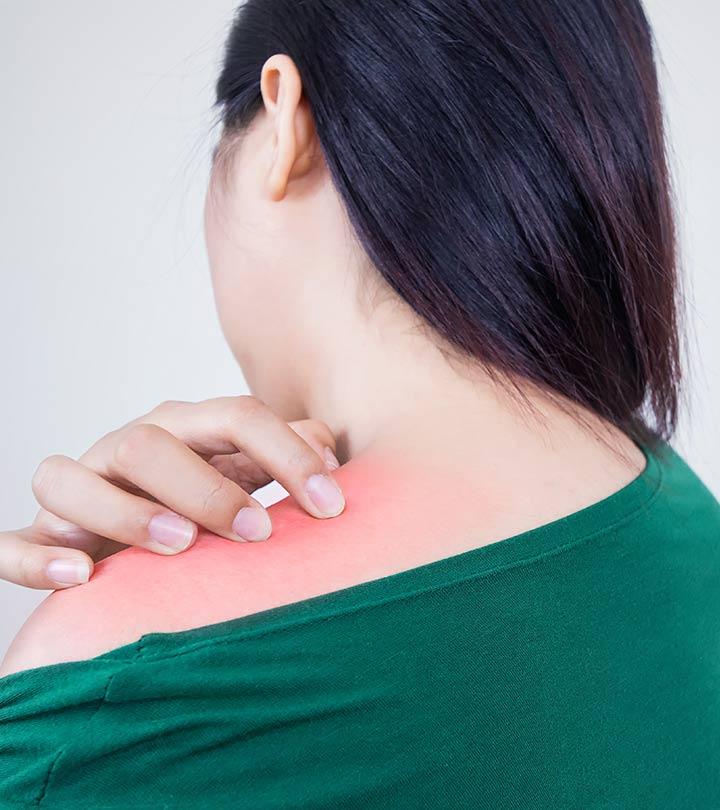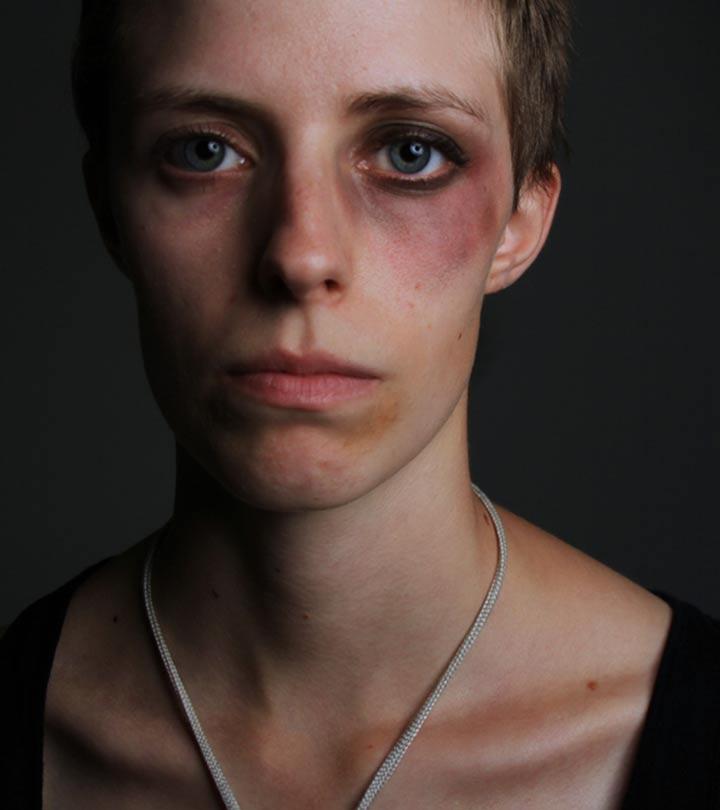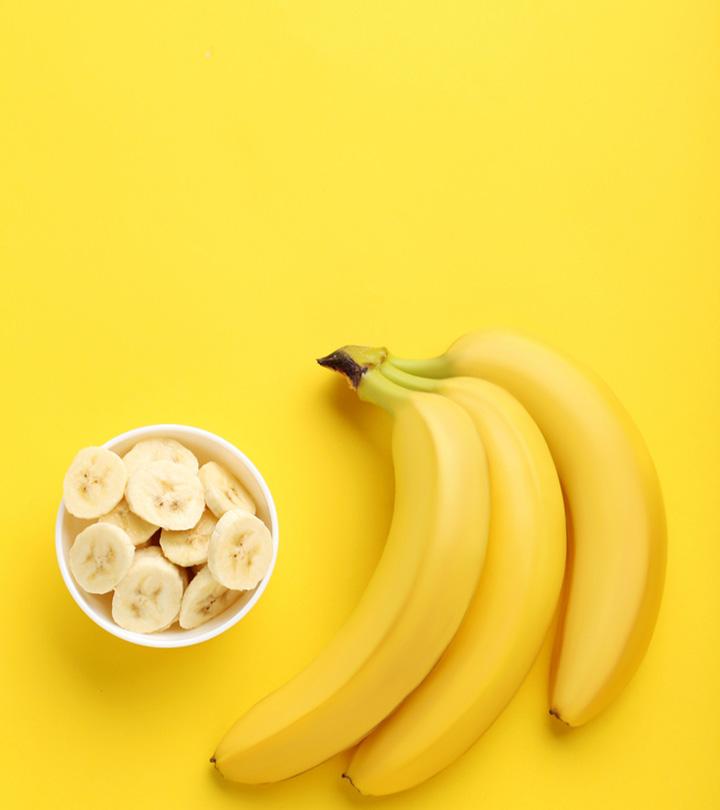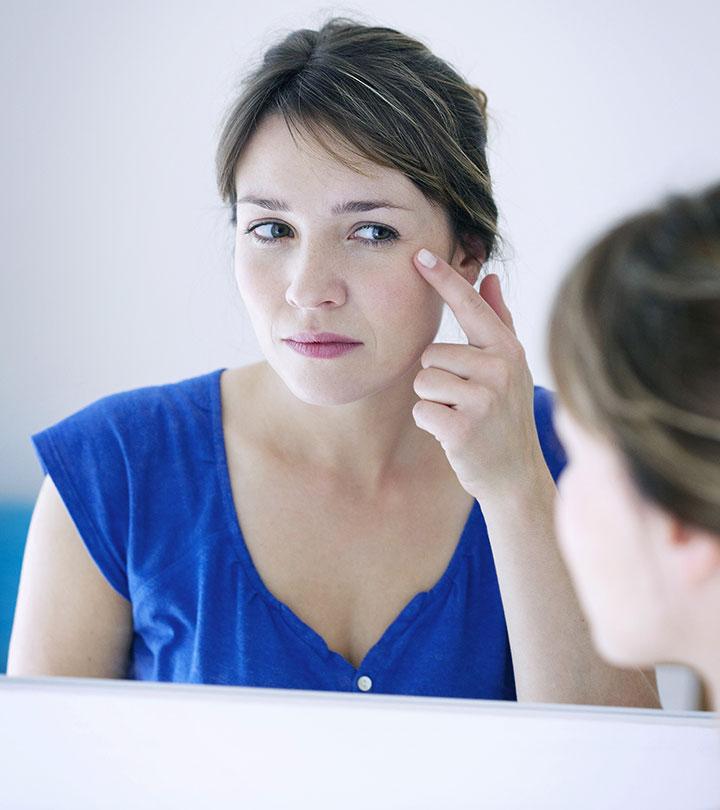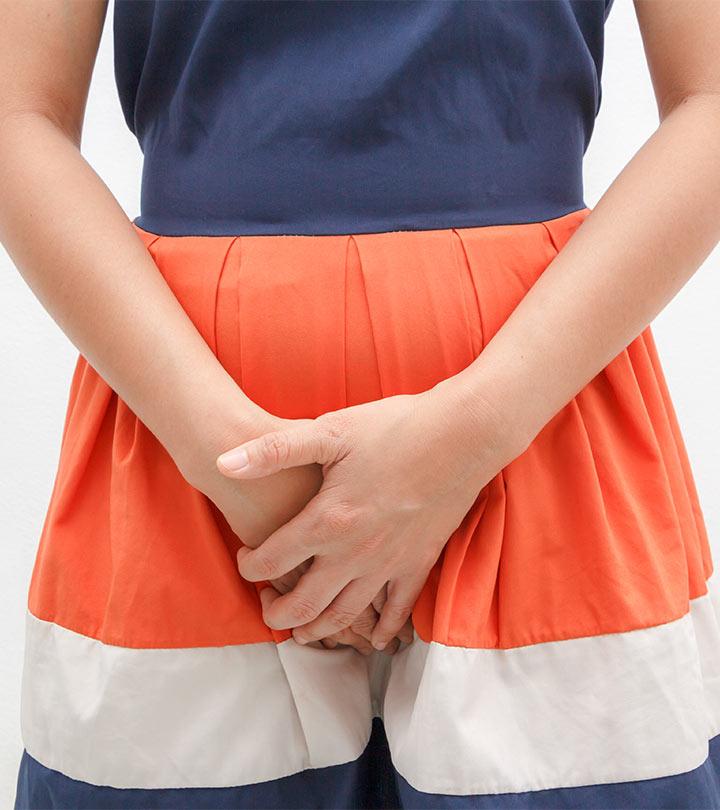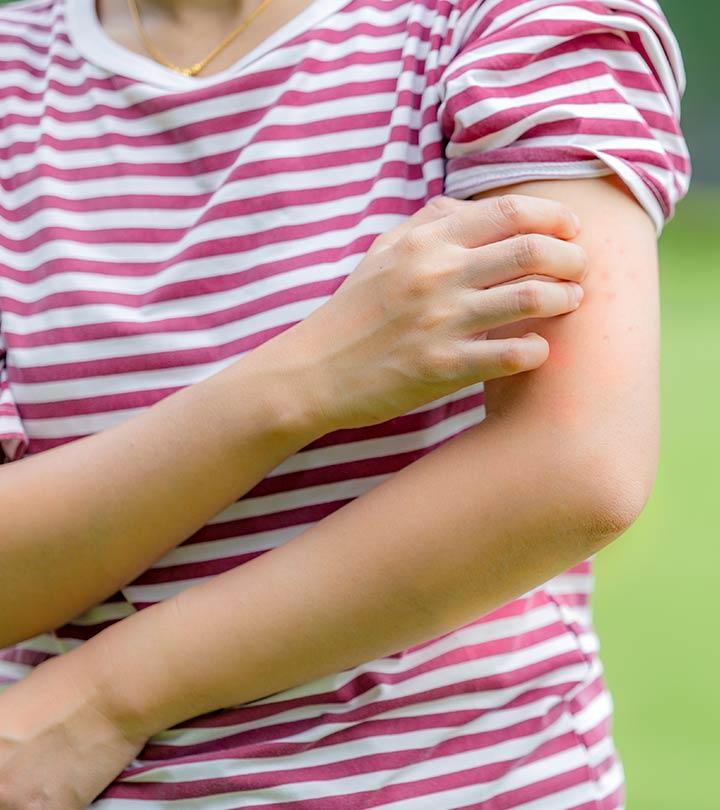13 Home Remedies To Get Rid Of Keloids Naturally
Be it aloe vera or laser therapy, these treatments may help reduce those raised scars.
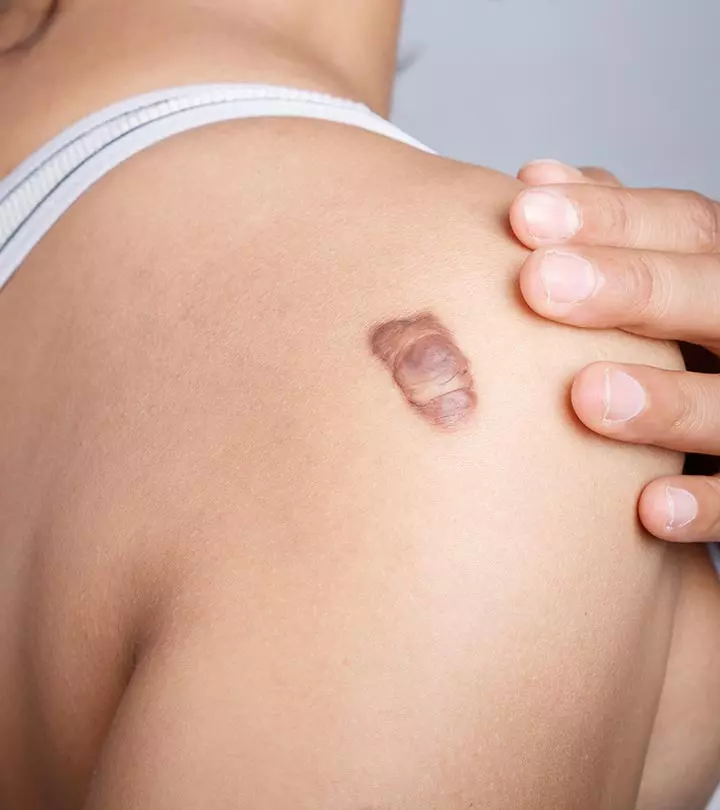
Image: shutterstock
Keloids are large thick scars that don’t stop growing and keep getting larger with time. Moreover, they might seem quite unsightly. If you are looking for ways to get rid of keloids, we have got you covered. These benign fibrous tumors of the skin are usually irregularly shaped, pink, have a smooth appearance, and keep increasing in size (1), (2). Hence, you may want to get rid of them naturally. While the home remedies listed below may not help you with how to get rid of a keloid completely, they may help you deal with the symptoms better. Continue reading to know more.
A multicenter cross-sectional study was conducted on 972 individuals with excessive scarring (keloids or hypertrophic scars) and compared to 229,106 controls. Out of the 972 individuals, females (65% vs 55%) and a lower proportion of White ethnicity (86% vs 95%) had excessive scarring when compared to the controls.
In This Article
What Are Keloids?
Keloids are fibrous growths due to abnormal wound healing in response to skin trauma or inflammation (1). These raised scars occur where the skin has healed and can be bigger than the original wound. Though keloids can appear anywhere on the body, they are commonly found on cheeks, earlobes, chest, and shoulders. However, not all scars that form after an injury are keloids. Keep reading to know how a keloid scar looks.
Symptoms Of Keloids
Keloid scars may develop as early as 1 to 3 months or even a year after the injury. The characteristics of a keloid scar are as follows:
- Flesh-colored or hyperpigmented lesion
- Raised scar with a flat surface
- It can be soft, lumpy, rubbery, or hard
- Itchy, painful, and tender
- It may become darker as it grows
Any type of wound that leaves behind scars. However, certain factors may cause overgrowth and keloid scar. Read on to know what causes keloid scars.
What Causes Keloid Scars?
Wound healing occurs in three stages: inflammatory, fibroblastic, and maturation. Keloid scars develop when the fibroblastic phase persists longer and unchecked. The connective tissues overreact, resulting in an overproduction of collagen and cytokines, forming keloid scars (1). Some of the common skin injuries that can cause keloid scarring are:
- Acne scars
- Ear piercing
- Surgical wounds
- Scratches
- Chickenpox
- Burns
- Insect bites
- Tattoos
- Vaccination sites
Annesha Adams, a lifestyle content creator, struggled with Keloids since she was 14 and shared her journey in her video. She says, “I have one keloid in my ear and one at the side of my leg (i).” She further adds that they look like 3D scars that do not heal at the same level as your skin, grow in size, and are itchy. Annesha further narrates, “You can get your keloid from any abrasion to your skin like piercing, that’s how I got my keloid.” She has been using steroid injections to treat it.
Some people might be at more risk of developing keloids. The risk factors include:
- People with a darker skin tone
- People of African, Asian, and Hispanic descent
- Pregnant people
- Teenagers going through puberty
- People with a family history of keloids
Keloids are hard to get rid of, but you may try some home remedies and medical treatments to shrink or soften them and promote skin healing. Keep reading to find out how.
How To Get Rid Of Keloids
- Apple Cider Vinegar
- Aspirin
- Lemon Juice
- Baking Soda
- Sandalwood And Rose Water
- Garlic
- Grapefruit Seed Extract
- Honey
- Aloe Vera Gel
- Petroleum Jelly
- Onion Juice
- Honey
- Rosehip Oil
Home Remedies For Keloids Removal
1. Apple Cider Vinegar For Keloids
Apple cider is a chemical exfoliant and astringent. It may help in minimizing the redness and size of the scar (3).
You Will Need
- Apple cider vinegar
- Water
What You Have To Do
- Dilute ACV with an equal amount of water.
- Apply the mixture to the keloid and leave it on for 30 minutes.
- Rinse it off with water.
How Often You Should Do This
Repeat this twice daily for 4-5 weeks.
2. Aspirin For Keloids
Topical aspirin is very useful in treating keloids. Its anti-inflammatory and exfoliating properties prove beneficial in this case (4). However, it should be used under a physician’s guidance.
You Will Need
- 3-4 aspirin tablets
- Water
What You Have To Do
- Make a smooth, thick paste of crushed aspirin tablets with water.
- Clean the scars, apply this paste, and let it dry.
- Wash it off and then apply moisturizer.
How Often You Should Do This
Apply this once every day or every alternate day.
3. Lemon Juice For Keloids
Vitamin C may help in proper wound healing and preventing keloid scars (5). Lemon is rich in vitamin C and may help reduce keloids to a certain extent. Anecdotal evidence suggests that within a few weeks of application, you will notice changes in the flexibility, texture, and color of the skin.
You Will Need
Lemon juice
What You Have To Do
- Apply lemon juice directly on the affected area and leave it on for 30 minutes.
- Wash the area with warm water.
How Often You Should Do This
Repeat this 2 times daily.
4. Baking Soda For Keloids
Baking soda is an abrasive agent that may help in exfoliating and keeping the skin clean. It also soothes irritated skin and reduces any swelling (6), (7). However, there is no scientific evidence to prove its effectiveness in treating keloids.
You Will Need
- 1 teaspoon of baking soda
- 3 teaspoons of 3% hydrogen peroxide
- Cotton ball
What You Have To Do
- Mix baking soda and hydrogen peroxide to form a smooth paste.
- Apply this paste to the affected area using a cotton ball and leave it on for 20 minutes.
- Rinse it off with water.
How Often You Should Do This
Repeat this 2 times daily
5. Sandalwood And Rose Water For Keloids
Sandalwood is known for its skin regenerating property, and rose water has anti-inflammatory properties and is a skin toner (8), (9). These properties may help manage keloids.
You Will Need
- 1-2 teaspoons of sandalwood powder
- Rose water
What You Have To Do
- Make a thick paste of sandalwood in rose water and apply it to the affected area before you go to bed.
- Leave it on overnight.
- Wash it off the next morning with warm water.
How Often You Should Do This
Do this every night.
6. Garlic
Garlic may speed up wound healing and may reduce the risk of scarring (10). Therefore, applying garlic may also prevent keloids.
You Will Need
1-2 garlic cloves
What You Have To Do
- Apply crushed garlic cloves on the scars and leave it for 15 minutes.
- Wash the area later with lukewarm water.
You can also use garlic oil instead of fresh garlic cloves.
How Often You Should Do This
Repeat this every day, preferably 2 times a day.
 Quick Tip
Quick Tip7. Grapefruit Seed Extract For Keloids
Grapefruit seed extract contains antioxidants, vitamin C, and phytochemical compounds that may aid in skin repair and reduce the risk of scars (11). This may help reduce the size of the keloids.
You Will Need
- 1 teaspoon of water
- 2-3 drops grapefruit seed extract
- Q-tip
What You Have To Do
- Dilute the grapefruit seed extract in water.
- Dip the Q-tip in this mixture and apply it to the keloid.
- Leave it on for as long as possible.
How Often You Should Do This
Do this 2 times a day.
8. Honey For Keloids
Honey prevents dead cells from accumulating in the affected area, enhances blood circulation, and speeds up the healing process (12). Tualang honey, in particular, is very effective in reducing keloids (13).
You Will Need
Honey
What You Have To Do
- Apply fresh honey directly to your scars.
- Massage gently and leave it on for 30-40 minutes.
- Rinse with water.
How Often You Should Do This
You can apply honey 2 times daily.
9. Aloe Vera Gel
Aloe vera gel has antiseptic and antibacterial properties that help in healing keloids (14). It also reduces soreness and inflammation and has wound healing properties (15).
You Will Need
An aloe leaf
What You Have To Do
- Cut open the leaf and extract the gel.
- Clean the affected area with lukewarm water and apply the aloe vera gel.
- Leave it for about 30 minutes before rinsing it off. You can also leave it on overnight.
How Often You Should Do This
Apply aloe vera gel 2 times a day.
10. Petroleum Jelly
A simple way to reduce keloid scars is to keep the area moisturized and hydrated at all times. Petroleum jelly, being an occlusive agent, traps the moisture and helps in scar removal (16). However, there is no scientific evidence to prove this effect.
You Will Need
Petroleum jelly
What You Have To Do
Clean the area and massage it with petroleum jelly.
How Often You Should Do This
Reapply the jelly 3-4 times in a day.
11. Onion Juice
The effectiveness of onions in reducing keloid and hypertrophic scars was tested a few years back. The study found that onion extract or juice could improve the appearance of the scars in a short period (17).
You Will Need
- 1 white onion
- A cheesecloth
- Cotton
What You Have To Do
- Chop the onion, place it in a cheesecloth, and squeeze out the onion juice.
- Apply this on the keloid scar with the cotton. There is no need to rinse it off.
How Often You Should Do This
Repeat this 3-4 times in a day.
12. Oils To Treat Keloids
Multiple combinations of oils may work in fading away keloid scars. Fish oil and mineral oil, in particular, help manage keloids (18). Some essential oils possess skin regenerating and healing properties, along with antioxidants, to aid the carrier oil in healing the keloids.
You Will Need
- 1 tablespoon of jojoba oil
- A few drops of rosehip seed oil
OR
- 1 tablespoon of virgin coconut oil
- Few drops of tea tree essential oil
- 1-2 drops of neem oil (optional)
OR A few drops of Jamaican black castor oil OR A few drops of frankincense essential oil
What You Have To Do
Apply a blend of the oils mentioned to the affected area and massage gently.
How Often You Should Do This
You can repeat this remedy several times every day for better results.
13. Rosehip Oil
Rosehip oil is derived from the fruits and the seeds of the wild rose bush. It is rich in antioxidants, fatty acids, and vitamins A and E, which may help improve skin texture, stimulate collagen production, restore damaged skin cells, and reduce the appearance of scars, including keloids (19). However, more studies are warranted to support these claims.
You Will Need
- A few drops of rosehip oil
What You Have To Do
- Clean the affected area with warm water and mild soap. Pat it dry gently.
- Gently massage a few drops of rosehip oil on the affected area and let it dry.
How Often You Should Do This
You can do this twice a day
These home remedies are easy, effective, and can help in scar treatment. However, they may not work for everyone. In such cases, it is better to consult a doctor for medical treatments.
Medical Treatments For Keloids
Removing keloids is not easy, and doctors often use a combination of more than one dermatology treatment for best results. The treatment options for keloids are as follows:
- Corticosteroid Injections: It may help shrink the scar and reduce the symptoms of itching and burning.
- Cryotherapy: It involves freezing the scar tissue to reduce the size and hardness of the scar.
- Surgical Excision: This surgical removal method involves cutting out the keloid through surgery. In most cases, the keloids may grow back if steroid injections and radiotherapies do not follow the surgery.
- Radiotherapy: It may help prevent the keloids from growing back after the surgery.
- Laser: This treatment helps flatten the keloid.
Other treatments like using silicone gel sheets, intralesional botox, or fluorouracil may also help reduce the size and improve the appearance of keloids. However, since treating keloids is not easy, it is always best if you can prevent them. Here are a few tips.
Prevention Tips
- Avoid body piercings, tattoos, and other cosmetic skin procedures as there are more chances of keloids developing after these procedures.
- Treat skin scars immediately rather than leaving them to heal on their own.
- Cover a new wound with petroleum jelly and a nonstick bandage. This pressure therapy helps prevent or reduce scarring by putting pressure on the healing wound.
 Quick Tip
Quick TipLiving With Keloids
Keloids are benign and may not need treatment. However, sometimes, the overgrowth may cause emotional distress. There is nothing wrong if you do not want to remove your keloid scars. If you feel they are affecting your daily life, causing pain and discomfort, you should consult a dermatologist to get them removed. These treatments can help minimize their appearance and reduce the pain and itchiness.
Infographic: Natural Ways To Get Rid Of Keloids
Keloids are raised scars that develop due to injuries or skin trauma. While some people are okay with keloids and choose to ignore them, others are bothered by their presence on their skin. We have rounded up some of the best ways to get rid of them from your skin naturally. Check out the infographic below to know more! Illustration: StyleCraze Design Team
Keloids are thick, raised scars on the skin that may grow bigger with time. While keloids are benign, you may choose to get rid of them for aesthetic or cosmetic reasons. Effective and simple home remedies to reduce the appearance of keloid scars include using apple cider vinegar, grapefruit seed extract, honey, aloe vera gel, garlic, baking soda, or lemon. Remember to conduct a patch test on your skin with your chosen remedies before applying it to the keloid to minimize the risk of adverse reactions. To prevent the formation of keloids, tend to a wound as soon as it starts healing by keeping it moisturized and evenly pressed. You need to follow the remedies for keloids diligently and regularly as keloids can be stubborn and take a while to disappear or fade in appearance.
Frequently Asked Questions
Can I flatten my keloid?
Dr. Emily Wood, MD, a board-certified dermatologist, says, “Yes, numerous methods exist to treat keloids. Typically, a combination of injections of Kenalog and 5-fluorouracil and laser can dramatically improve keloids.”
Should I be worried about keloids?
Dr. Wood says, “Keloids themselves are not worrisome, although they can be painful. If you have a rapidly growing or changing keloid, I recommend getting it checked to ensure it is not a rare type of cancer that can sometimes mimic a keloid called dermatofibrosarcoma protruberans.”
Can keloids turn cancerous?
Dr. Natalie Kash, MD, FAAD, a board-certified dermatologist, says, “Although true keloids do not usually turn cancerous themselves, there are other conditions, such as cancers, that can look like a keloid. Thus, I would recommend having any concerning skin lesion checked out by a dermatologist to get an accurate diagnosis before assuming what it is and trying to treat it at home.”
Does massaging help keloids?
According to Dr. Kash, “In some cases, massage can help keloids; however, in other cases, chronic rubbing or friction can actually cause the keloid to grow.”
Can Vaseline treat keloids?
According to Dr. Wood, “Vaseline does not treat keloids. However, it will not harm keloids if applied.”
Are keloid scars contagious?
A keloid scar is not contagious at all. It is the result of skin injury that you have suffered personally and will spread with contact.
Are Keloid Scars Contagious?
A keloid scar is not contagious at all. It is the result of skin injury that you have suffered personally and will spread with contact.
Are keloids dangerous?
No, they are not dangerous. They mostly develop at a site of a previous skin injury and can be treated easily.
Will I need surgery to get rid of the keloid?
You may need surgery if the keloid is big and does not reduce in size with home remedies. Consult your doctor to get more clarity on the issue.
Will an over-the-counter cream help keloid?
Yes, an over-the-counter cream may help reduce the appearance of the keloid. However, it is best to consult your doctor before applying any creams.
Can I get rid of a keloid on my piercing?
Yes, a keloid on the piercing can be removed by surgical excision.
What happens if you scratch a keloid?
Scratching a keloid may make it grow due to the excess growth of scar tissue.
Is it good to massage keloid scars?
Massaging a keloid scar may not affect or reduce its appearance and size.
Can you pop a keloid?
No, you should not pop a keloid. Keloids do not have any deposits that you can pop out. Moreover, picking or “popping” a keloid can increase the risk of infection.
Does salt water reduce keloids?
There is no scientific evidence to suggest that salt water can reduce keloids. However, many users claim that washing the scar with sea salt water can help with the inflammation on the site.
Can you cut off a keloid with scissors?
No. Slicing or cutting off a keloid increases the risk of an even bigger keloid developing on the same site.
Key Takeaways
- Keloids are thick scars caused due to scar tissue deposition, usually following an injury or incision.
- Overproduction of collagen and cytokines forms keloids. Most keloids keep growing and become unsightly and uncomfortable.
- You can use home remedies to treat keloids using ingredients like apple cider vinegar, aloe vera gel, vitamin E oil, tea tree oil, onion extract, silicone sheets, etc.
- Medical treatment for keloids involves injection, surgery, laser, or radiotherapy.
- Early care of wounds and proper treatment can prevent scarring and keloid formation.
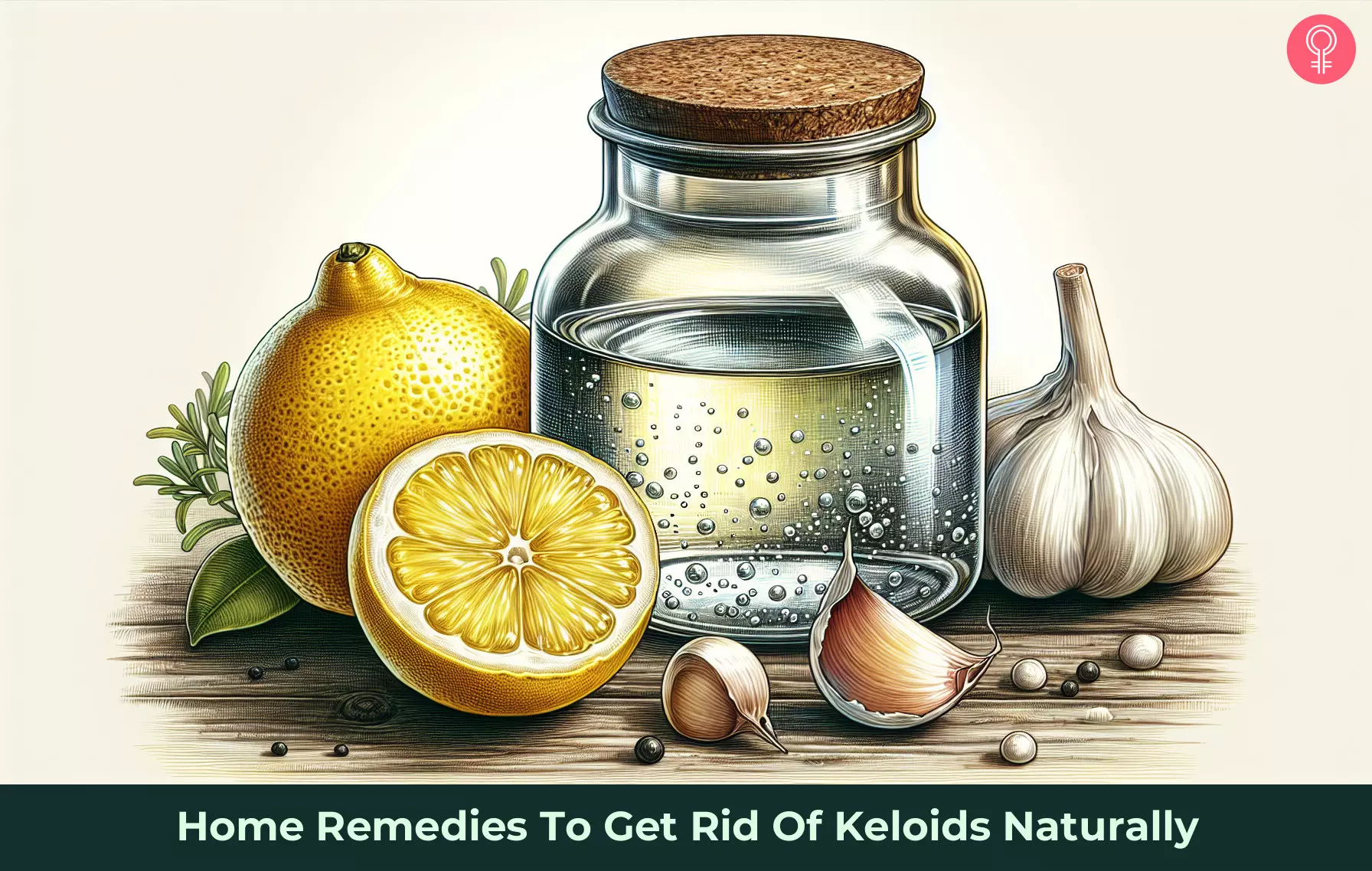
Image: Dall·E/StyleCraze Design Team
Check out this video to learn about keloid and hypertrophic scars and tips to get rid of them. Learn about natural remedies for smoother, healthier skin and say goodbye to scars!
Personal Experience: Source
StyleCraze's articles are interwoven with authentic personal narratives that provide depth and resonance to our content. Below are the sources of the personal accounts referenced in this article.
i. My keloid story *EXPLICIT* with photos (how to get rid of them + what are they)https://www.youtube.com/watch?v=IdXyaoAg3SE
References
Articles on StyleCraze are backed by verified information from peer-reviewed and academic research papers, reputed organizations, research institutions, and medical associations to ensure accuracy and relevance. Read our editorial policy to learn more.
- McGinty S, Siddiqui WJ. Keloid. [Updated 2020 Jan 10]. In: StatPearls [Internet]. Treasure Island (FL): StatPearls Publishing, 2020 Jan. https://www.ncbi.nlm.nih.gov/books/NBK507899/
- Kelly, A P. “Keloids.” Dermatologic clinics vol. 6,3 (1988): 413-24. https://pubmed.ncbi.nlm.nih.gov/3048824/
- Gaston, Anca, and Robert F Garry. “Topical vitamin A treatment of recalcitrant common warts.” Virology journal vol. 9 21. https://pubmed.ncbi.nlm.nih.gov/22251397/
- Edriss, A S, and J Mesták. “Management of keloid and hypertrophic scars.” Annals of burns and fire disasters vol. 18,4 (2005): 202-10. https://www.ncbi.nlm.nih.gov/pmc/articles/PMC3187998/
- Pullar, Juliet M et al. “The Roles of Vitamin C in Skin Health.” Nutrients vol. 9,8 866. 12 Aug. 2017, doi:10.3390/nu9080866 https://www.ncbi.nlm.nih.gov/pmc/articles/PMC5579659/
- Milstone, Leonard M. “Scaly skin and bath pH: rediscovering baking soda.” Journal of the American Academy of Dermatology 62.5 (2010): 885-886. https://www.jaad.org/article/S0190-9622(09)00493-9/abstract
- Quandt, Sara A et al. “Home Remedy Use Among African American and White Older Adults.” Journal of the National Medical Association vol. 107,2 (2015): 121-9. https://www.ncbi.nlm.nih.gov/pmc/articles/PMC4631220/
- Kumar, Dinesh. “Anti-inflammatory, analgesic, and antioxidant activities of methanolic wood extract of Pterocarpus santalinus L.” Journal of pharmacology & pharmacotherapeutics vol. 2,3 (2011): 200-2. https://www.ncbi.nlm.nih.gov/pmc/articles/PMC3157138/
- Boskabady, Mohammad Hossein et al. “Pharmacological effects of rosa damascena.” Iranian journal of basic medical sciences vol. 14,4 (2011): 295-307. https://www.ncbi.nlm.nih.gov/pmc/articles/PMC3586833/
- Alhashim, Minhal, and Jamie Lombardo. “Effect of Topical Garlic on Wound Healing and Scarring: A Clinical Trial.” Dermatologic surgery : official publication for American Society for Dermatologic Surgery [et al.] vol. 46,5 (2020): 618-627. doi:10.1097/DSS.0000000000002123 https://pubmed.ncbi.nlm.nih.gov/31490311/
- Moalla Rekik, Dorsaf et al. “Evaluation of Wound Healing Properties of Grape Seed, Sesame, and Fenugreek Oils.” Evidence-based complementary and alternative medicine : eCAM vol. 2016 (2016): 7965689. https://www.ncbi.nlm.nih.gov/pmc/articles/PMC5136421/
- Ediriweera, E R H S S, and N Y S Premarathna. “Medicinal and cosmetic uses of Bee’s Honey – A review.” Ayu vol. 33,2 (2012): 178-82. https://www.ncbi.nlm.nih.gov/pmc/articles/PMC3611628/
- Nurul Syazana, Mohamad Shah et al. “Antiproliferative effect of methanolic extraction of tualang honey on human keloid fibroblasts.” BMC complementary and alternative medicine vol. 11 82. https://pubmed.ncbi.nlm.nih.gov/21943200/
- Fulton, J E Jr. “The stimulation of postdermabrasion wound healing with stabilized aloe vera gel-polyethylene oxide dressing.” The Journal of dermatologic surgery and oncology vol. 16,5 (1990): 460-7. https://pubmed.ncbi.nlm.nih.gov/2341661/
- Surjushe, Amar et al. “Aloe vera: a short review.” Indian journal of dermatology vol. 53,4 (2008): 163-6. https://www.ncbi.nlm.nih.gov/pmc/articles/PMC2763764/
- Commander, Sarah Jane et al. “Update on Postsurgical Scar Management.” Seminars in plastic surgery vol. 30,3 (2016): 122-8. https://www.ncbi.nlm.nih.gov/pmc/articles/PMC4961501/
- Hosnuter, M et al. “The effects of onion extract on hypertrophic and keloid scars.” Journal of wound care vol. 16,6 (2007): 251-4. https://pubmed.ncbi.nlm.nih.gov/17722521/
- Olaitan, Peter B et al. “Inhibitory activities of omega-3 Fatty acids and traditional african remedies on keloid fibroblasts.” Wounds : a compendium of clinical research and practice vol. 23,4 (2011): 97-106. https://www.ncbi.nlm.nih.gov/pmc/articles/PMC3905615/
- Phetcharat, L et al. “The effectiveness of a standardized rose hip powder, containing seeds and shells of Rosa canina, on cell longevity, skin wrinkles, moisture, and elasticity.” vol.10 (2015)
https://www.ncbi.nlm.nih.gov/pmc/articles/PMC4655903/
Read full bio of Dr. Sameeksha Chand
- Dr. Emily Wood, MD, is a board-certified dermatologist and fellowship-trained cosmetic dermatologic surgeon specializing in cosmetic and medical dermatology. She has six years of experience in skin rejuvenation therapies, fillers, liposuction, sclerotherapy, and skin tightening. Dr. Wood graduated from Texas A&M University Health Science Center College of Medicine.
 Dr. Emily Wood, MD, is a board-certified dermatologist and fellowship-trained cosmetic dermatologic surgeon specializing in cosmetic and medical dermatology. She has six years of experience in skin rejuvenation therapies, fillers, liposuction, sclerotherapy, and skin tightening. Dr. Wood graduated from Texas A&M University Health Science Center College of Medicine.
Dr. Emily Wood, MD, is a board-certified dermatologist and fellowship-trained cosmetic dermatologic surgeon specializing in cosmetic and medical dermatology. She has six years of experience in skin rejuvenation therapies, fillers, liposuction, sclerotherapy, and skin tightening. Dr. Wood graduated from Texas A&M University Health Science Center College of Medicine.
Read full bio of Anjali Sayee
Read full bio of Monomita Chakraborty





